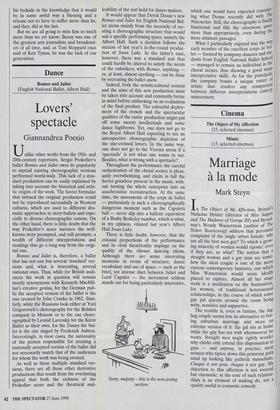Dance
Romeo and Juliet (English National Ballet, Albert Hall)
Lovers' spectacle
thannandrea Poem()
Unlike other works from the 19th- and 20th-century repertoire, Sergei Prokofiev's ballet Romeo and Juliet owes its popularity to myriad existing choreographic versions performed world-wide. This lack of a stan- dard production can be easily explained by taking into account the historical and artis- tic origins of the work. The Soviet formulae that imbued the original production could not be reproduced successfully in Western cultures, which are used to different dra- matic approaches to story-ballets and espe- cially to diverse choreographic canons. On the other hand, there is little doubt that the way Prokofiev's score narrates the well- known story prompted, and still prompts, a wealth of different interpretations and readings that go a long way from the origi- nal one.
Romeo and Juliet is, therefore, a ballet that has not one but several 'standard' ver- sions and, what is interesting, several national ones. Thus, while for British audi- ences the work in question will remain mostly synonymous with Kenneth MacMil- lan's creative genius, for the German pub- lic the accepted version of the ballet is the one created by John Cranko in 1962. Simi- larly, while the Russians look either at Yuri Grigorovich's choreography for the Bolshoi company in Moscow or to the one chore- ographed by Leonid Lavroskji for the Kirov Ballet as their own, for the Danes the bal- let is the one staged by Frederick Ashton. Interestingly, in most cases, the nationality of the person responsible for creating a nationally accepted version of the ballet did not necessarily match that of the audiences for whom the work was being created.
As well as these multiple standard ver- sions, there are all those other derivative productions that result from the everlasting appeal that both the richness of the Prokofiev score and the theatrical mal- leability of the text hold for dance-makers.
It would appear that Derek Deane's new Romeo and Juliet for English National Bal- let stems mainly from the necessity of cre- ating a choreographic structure that would suit a specific performing space, namely the Albert Hall. Such a decision follows the success of last year's in-the-round produc- tion of Swan Lake. In the latter's case, however, there was a standard text that could hardly be altered to satisfy the needs of the onlookers; with Romeo, anything or, at least, almost anything — can be done by recreating the ballet anew.
Indeed, both the artistic/cultural context and the aims of this new production must be taken into account and constantly borne in mind before embarking on an evaluation of the final product. The colourful deploy- ment of the crowds and the spectacular qualities of the entire production might put off some snooty intellectuals and some dance highbrows. Yet, one does not go to the Royal Albert Hall expecting to see an introspective choreographic depiction of the star-crossed lovers. In the same way, one does not go to the Verona arena if a `spectacle' is not what one wants to see. Besides, what is wrong with a spectacle?
Throughout the performance the careful orchestration of the choral scenes is pleas- antly overwhelming, and elicits in full the Soviet grandeur present in the music, with- out turning the whole enterprise into an anachronistic reconstruction. At the same time, the movements of the corps de ballet — particularly in such a choreographically dangerous moment such as the Capulets ball — never slip into a balletic equivalent of a Busby Berkeley number, which is what, in my opinion, vitiated last year's Albert Hall Swan Lake.
There is little doubt, however, that the colossal proportions of the performance and its vivid theatricality impinge on the quality of the chosen dancing idiom. Although there are some interesting moments in terms of structure, dance vocabulary and use of space — such as the brief, yet intense duet between Juliet and Lord Capulet — the movement seldom stands out for being particularly innovative, `Sorry, majesty - this is the non-jesting section.' which one would have expected consider- ing what Deane recently did with The Nutcracker. Still, the choreography is fluidly functional and fills the enormous spa more than appropriately, even during the more intimate passages. What I particularly enjoyed was the way each member of the excellent corps de bal- let — formed by company dancers and stu- dents from English National Ballet School — managed to remain an individual in the choral scenes, thus showing a good many interpretative skills. As for the principals, the company boasts a unique roster of artists that renders any comparison between different interpretations entirely unnecessary.


























































 Previous page
Previous page